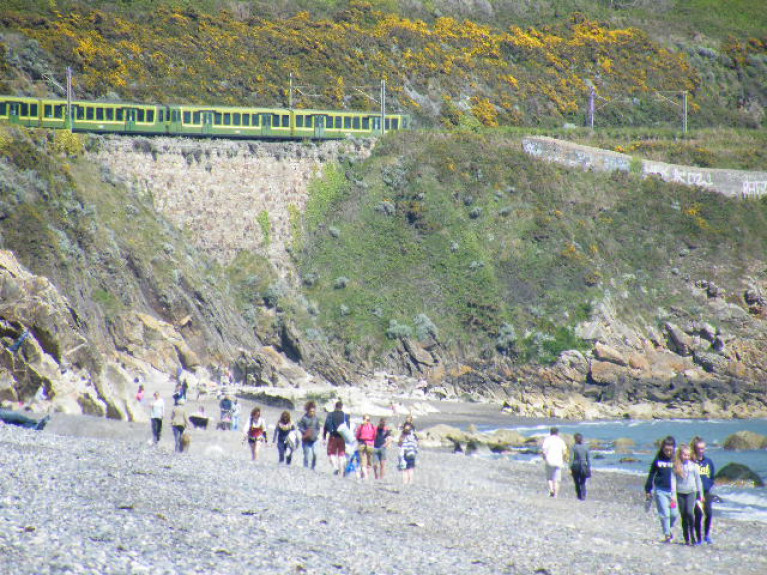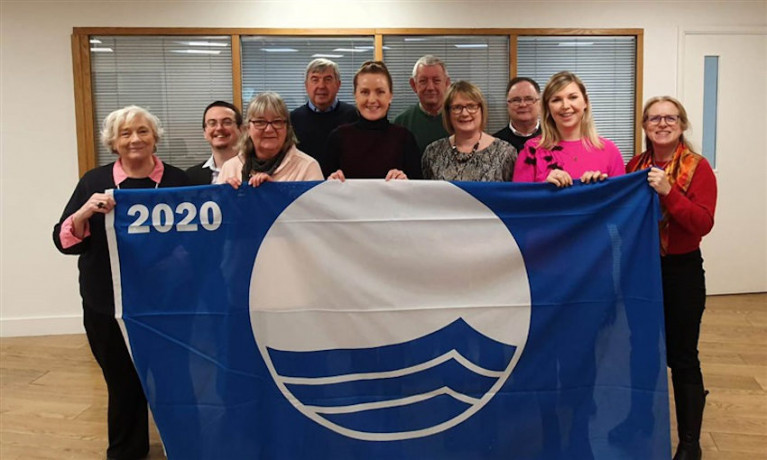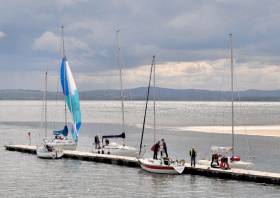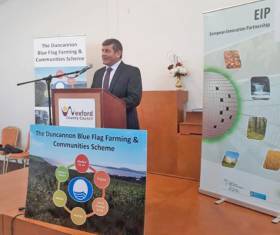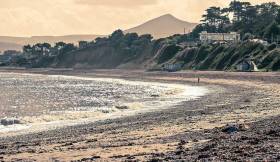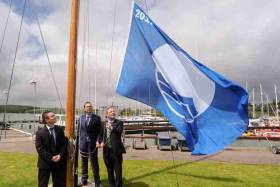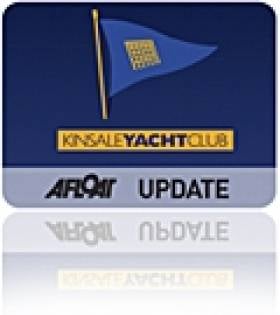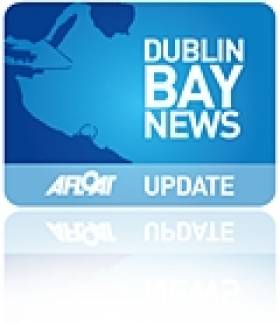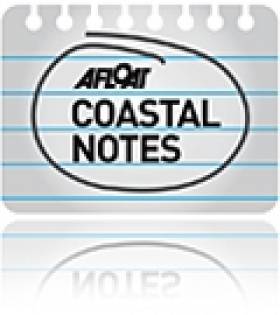Displaying items by tag: Blue Flag
All Ten Irish Marinas Retain Blue Flag Status for 2022
All ten Irish marinas awarded in 2021 have retained Blue Flag status for the coming season.
85 Beaches and 10 marinas were awarded the Blue Flag for 2022 by Malcolm Noonan TD, Minister of State with responsibility for Heritage and Electoral Reform at a ceremony at Curracloe Beach in County Wexford this afternoon.
79 of the 83 beaches awarded in 2021 retained Blue Flag Status for the 2022 bathing season.
Download the details below as PDF files
Blue Flag Marinas Awarded for 2022
- County Name
- Cork Kinsale Yacht Club
- Cork The Royal Cork Yacht Club Marina
- Clare Kilrush Marina
- Donegal Greencastle Marina
- Donegal Rathmullan Marina
- Kerry Fenit Marina
- Kerry Portmagee Seasonal Pontoon
- Westmeath Quigley's Marina, Killinure Point
- Wexford Kilmore Quay Marina
- Wexford New Ross Marina
 Blue Flag status - The Royal Cork Yacht Club Marina in Cork Harbour Photo: Bob Bateman
Blue Flag status - The Royal Cork Yacht Club Marina in Cork Harbour Photo: Bob Bateman
Five beaches awarded in 2021 that have not been awarded for the 2022 season are: Bray South Promenade in Wicklow; Warren, Cregane Strand in Cork; Traught, Kinvara in County Galway; Carrowmore and Clare Island in County Mayo. None of these beaches achieved the “Excellent” water quality classification necessary to be awarded the Blue Flag. Each of the sites received a classification of “Good”, the second highest classification available based on an analysis of bathing water samples over the past four bathing seasons.
Speaking at the awards ceremony Minister Noonan stated that: "This year celebrates 35 years of the Blue Flag as an international programme and during that time the Blue Flag has become an internationally recognised symbol of high standards in water quality, environmental management, environmental education and safety. I am pleased to be presenting 95 blue flags and 62 green coast awards today and want to commend the great efforts made by local authorities, An Taisce, coastal communities and volunteers for their work around the country.
Mr. Ian Diamond, Coastal Awards Manager for An Taisce in announcing this year’s Blue Flag and Green Coast Award recipients stated:
"We were delighted to be welcomed to the Sunny Southeast today for the opportunity to celebrate the beaches and marinas awarded for the 2022 season. It takes a lot of hard work and dedication to manage a beach or marina to the excellent standards required by these award programmes. It’s been too long since we’ve had the opportunity to acknowledge these efforts in person, and I would like to thank all in attendance and our hosts Wexford County Council for helping us make today’s event worth the wait”.
Blue Flag
The Blue Flag is one of the world’s most recognised eco-labels. Originating in Frnace in 1985 it was launched as an International programme as part of the "European Year of the Environment in 1987. In 1988, the first year sites were awarded outside of France 19 beaches and 2 marinas received the Blue Flag in Ireland. 2022 is the 35th year that beaches and marinas have been awarded here in Ireland and the 95 beaches and marinas being awarded is the highest annual total to date.
The programme aims to raise environmental awareness and promote sound environmental management of beaches, marinas and eco-tourism boats around the world. The 85 Irish beaches and 10 marinas that have achieved this accolade must adhere to specific criteria related to water quality, information provision, environmental education, safety and site management.
Award highlights
- The number of sites receiving the award is up 2 on last year’s total.
- 7 beaches not awarded in 2021 have been awarded for the coming bathing season. These are: Trá Inis Oírr (Main Beach) in County Galway; Fountainstown and Youghal Front Strand in County Cork; Balcarrick, Donabate and Rush, South Beach in Fingal; Ballybunnion North Beach in Kerry and Ballymoney North Beach, in County Wexford.
- Trá Inis Oírr, the main beach on Inis Oirr in County Galway has been awarded a Blue Flag for the first time this year.
- In Cork, Fountainstown has been awarded for the first time since 1991 and the second time since Blue Flags were first awarded in Ireland.
- Youghal Front Strand in Cork will fly the Blue Flag for the first time since 2011.
- Balcarrick, Donabate in Fingal has been awarded a Blue Flag for the first time since 2016.
- Ballybunnion North Beach, which last flew a Blue Flag in 2019 has been awarded for the 2022 bathing season.
- Ballymoney North Beach, in County Wexford regains Blue Flag status having not been awarded in 2021.
- 79 of the 83 beaches awarded in 2021 retained Blue Flag Status for the 2022 bathing season.
- The 5 beaches awarded in 2021 that have not been awarded for the 2022 season are: Bray South Promenade in Wicklow; Warren, Cregane Strand in Cork; Traught, Kinvara in County Galway; Carrowmore and Clare Island in County Mayo. None of these beaches achieved the “Excellent” water quality classification necessary to be awarded the Blue Flag. Each of the sites received a classification of “Good”, the second highest classification available based on analysis of bathing water samples over the past four bathing seasons.
- All 10 marinas awarded in 2021 have retained Blue Flag status for the coming season.
Blue Flags totalling a record 93 have been awarded to beaches and marinas across the country for the 2021 bathing season.
Four additional beaches are receiving the award this year, which is given for compliance with sewage treatment as well as for the quality of bathing water.
Four new beaches are among the 93 Blue Flags awarded by An Taisce for this year's bathing season.
They include two beaches in Cork. Inchydoney East Beach has achieved Blue Flag Status for the first time. While Warren, Cregane Strand gets its Blue Flag status back for the first time since 2013.
More from RTE News
Irish Sailing’s McAllister On Jury Duty For Blue Flag Awards
Irish Sailing’s regional development officer Gail McAllister is among the jury for this year’s Blue Flag awards programme.
The national jury met last month to consider a total of 88 sites around Ireland comprising 80 beaches and eight marinas.
Their decisions will now be presented for evaluation to the Blue Flag International Jury and the results will be released in advance of the coming summer season.
Last year’s awards saw 80 out of 83 beaches retain their Blue Flag from 2018, while the number of rated marinas rose to eight with the inclusion of Rathmullan in Donegal.
“It is an honour to be part of this international scheme and I am excited to bring some new ideas to the Irish Sailing Sustainability Awareness programme,” said McAllister, who has also joined An Taisce as a ‘Climate Ambassador’.
Three beaches in the North West have lost their Blue Flags in the latest round of awards from An Taisce.
According to The Irish Times, the popular surfing haunt of Bundoran in Co Donegal, along with Bertra Strand and Golden Strand in Co Mayo, failed to retain Blue Flag status in this year’s awards, which were announced today (Monday 20 May) at The Armada Hotel in Midtown Malbay, Co Clare.
However, Rathmullan Marina in Co Donegal secured its first ever Blue Flag to bring the overall numbers to just two down on last year’s total.
In total, 80 of the 83 beaches awarded in 2018 retained their Blue Flag status, while all seven marinas rated last year — including the Royal Cork and Kinsale yacht clubs — have kept their flags.
Blue Flag beaches and marinas must adhere to specific criteria related to water quality, information provision, environmental education, safety and site management.
In addition, 62 beaches have received the Green Coast Award for the 2018 bathing season — the highest number to date.
The Green Coast Award recognises beaches managed in partnership with local volunteer groups for their clean environment, excellent water quality and natural beauty.
The full list of Blue Flag and Green Coast Award recipients for this year is available to download below.
Duncannon Beach ‘Blue Flag’ Scheme Launches In Wexford
#CoastalNotes - A new locally led scheme for the recovery and long-term retention of Duncannon Beach’s Blue Flag status has been launched in Co Wexford.
The Duncannon Blue Flag Farming and Communities Scheme is a European Innovation Project (EIP) funded by the Department of Agriculture, Food and the Marine that will deal with pollution from both agricultural and domestic sources.
The project is one of 23 EIPs or locally led schemes funded by the department under the current Rural Development Programme.
The Duncannon Blue Flag Farming and Communities Scheme has been allocated €550,000 to improve the bacterial quality of the two coastal streams that flow onto Duncannon Beach, which has steadily improved its bathing water quality from ‘sufficient’ in 2016 to ‘good’ in 2017 in the EPA’s most recent Bathing Water Quality in Ireland report.
The scheme applies the Water Framework Directive principles of Integrated Catchment Management whereby a range of pollution sources are considered in unison for multiple benefits in an integrated, holistic manner.
Speaking at the launch, Andrew Doyle, Minister of State at the Department of Agriculture, Food and the Marine, said: “One of the objectives of this scheme is to generate a greater sense of local ownership, responsibility and appreciation for the local water environment in the Duncannon area.
“Its implementation will, through the co-operation of all local stakeholders, ultimately bring about improved water quality and a better environment in this area.”
The operational group for the project is representative of a number of stakeholders and is led by Wexford County Council. It also includes personnel from Teagasc, local agricultural consultants, Glanbia, Bord Bia, the local farming community and the IFA.
“This is exactly the type of scheme that was envisaged when my department chose to drive the EIP initiative under the current Rural Development Programme,” said Minister Doyle. “It complements extremely well the many other water quality improvement projects which my department is supporting.
“As with all EIP projects, the knowledge from this project will be shared, through the EIP network, with similar communities throughout Ireland and will help to improve water quality in other sensitive catchments areas.”
A total of €59 million is being made available for EIP projects by the Department of Agriculture, Food and the Marine. €24m of this is allocated to smaller EIP projects chosen by a competitive Open Call process. Another €35m is available for the hen harrier and freshwater pearl mussel projects.
Dublin & Donegal Beaches Lose Out On Blue Flags In Record Year For Irish Bathing Quality Overall
#CoastalNotes - Two beaches in the Dublin area and one in Donegal have lost their Blue Flag status in the latest list of EU beach quality awards.
According to TheJournal.ie, Balcarrick in Donabate, North Co Dublin and Killiney in South Dublin both fell short of the EU’s standards for bathing water quality this year.
Lisfannon in Co Donegal was also left off the list in 2017, which overall was a record year for Ireland with 88 Blue Flags awarded nationwide – three more than last year.
Galway coastal residents will be happy to see Portumna get its first Blue Flag, after recent reports of poor bathing quality at three other beaches in the county.
And the promenade at Bray in North Co Wicklow regains its Blue Flag status for the first time since 2000.
As reported earlier today on Afloat.ie, seven Irish marinas have been awarded Blue Flags this year, with Greencastle in Co Donegal achieving top status for the first time.
Seven Irish Marinas were awarded Blue Flags yesterday at the annual awards scheme hosted by Royal Cork Yacht Club in Cork Harbour. Royal Cork's own marina was one of the seven facilities to receive an award. Greencastle Marina in County Donegal raises the flag for the first time this year.
The Blue Flag programme promotes sustainable development in freshwater and marine areas and challenges local authorities and beach operators to achieve high standards in water quality, environmental management, environmental education and safety.
The Blue Flag has been operating in Ireland since 1987, in 1988 the first year flags were awarded here two marinas received the award.
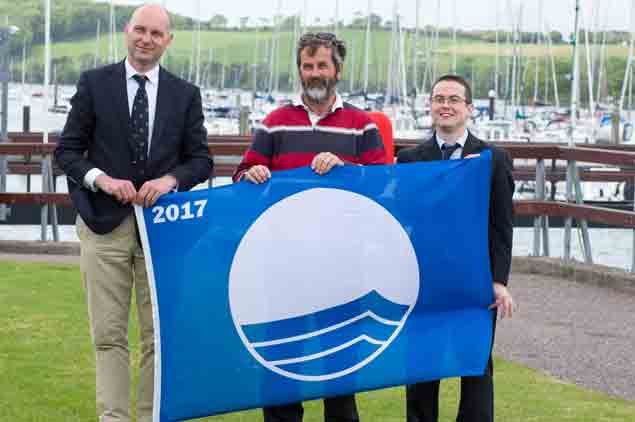 Kinsale Yacht Club's 2017 Blue Flag: Matthias Hellstern, KYC Rear Commodore, Brian Hunt (KYC General Manager) and Ian Diamond of An Taisce Photo: Bob Bateman
Kinsale Yacht Club's 2017 Blue Flag: Matthias Hellstern, KYC Rear Commodore, Brian Hunt (KYC General Manager) and Ian Diamond of An Taisce Photo: Bob Bateman
In Cork, The first of the current Blue Flag marinas to achieve Blue Flag status again is Kinsale Yacht Club.
The county with the most Blue Flags is Kerry: with 13 beaches and one marina at Fenit but Wexford is the county with the most blue flag marinas with Kilmore Quay and New Ross Marina both retaining their status.
Quigley's Marina in County Westmeath at Killinure Point on the River Shannon retained it's Blue Flag status for the coming season.
Kinsale Yacht Club has won a blue flag for its coastal marina for the first time in today's An Taisce announcement of the International Blue Flag Awards for 2015.
A total of 144 awards were presented by the Minister for the Environment, Community and Local Government, Mr. Alan Kelly, T.D, at an awards ceremony held on Ballinskelligs Beach in Kerry. Ireland's diverse coastline with long sandy beaches, bustling promenades and rocky shores have something for everyone.
Kinsale Yacht Club marina is located in a natural, virtually land-locked harbour on the estuary of the Bandon River, approximately 12 miles south west of Cork harbour entrance. It is home to a thriving fishing fleet as well as frequented by commercial shipping, it boats two fully serviced marinas, with the Kinsale Yacht Club & Marina being the closest to the town.Visitors to this marina automatically become temporary members of the club and are therefore entitled to make full use of the facilities.
Speaking at the awards ceremony Minister Kelly said, "Blue Flags represent excellence. They are a clear signal of quality and are something to be cherished. I am delighted to announce that today we will be awarding a total of 86 Blue Flags; 81 for beaches and five for marinas. A blue flag flying at a particular location means that it has achieved excellent water quality to standards set by European and national Regulations, and a very high grade across a wide range of other criteria"
He added that, "This is testament to the sterling efforts of local authorities, An Taisce and of local communities in ensuring that their beaches meet the standards of excellence required for a Blue Flag or Green Coast Award',
81 beaches and 5 marinas were awarded the prestigious Blue Flag award representing an increase in 6 Blue Flag awards since 2014.
Ms Annabel FitzGerald, Coastal Programmes Manager said that, "The Blue Flag is an award of excellence, the beaches and marinas that have achieved this accolade today have complied with strict criteria relating to water quality, safety, facilities for visitors, beach management, environmental education and the provision of information."
In Cork, Redbarn and Garretstown have regained the Blue Flag status and in Wexford, Ballinesker is being awarded the Blue Flag for the first time. 5 beaches that failed to comply with the requirements of Blue Flag in 2014 because of storm damage have regained their Blue Flag status, they are Bertra and Mulranny in Mayo, Rossbeigh in Kerry and Miltown Malbay and Spanish Point in Clare.
Brittas Bay North in Wicklow, Enniscrone in Sligo and Skerries in Fingal have lost their Blue Flags due to failure to comply with water quality requirements for the Blue Flag.
58 beaches in Ireland were awarded the Green Coast Award representing an increase in 4 awards since 2014. Bishopsquarter and Seafield in Clare and Inchydoney East in Cork are being awarded for the Green Coast Award for the first time. In Wexford, Ballyhealy, Ballymoney, Booley Bay, Grange and St Helens Bay have also achieved the accolade.
Having not met the excellent standard required, Skerries in Fingal, Rathmullan in Donegal, Enniscrone in Sligo and Ballycastle in Mayo did not regain the Green Coast Award for 2015.
"The Green Coast Award recognises beaches for their clean environment, excellent water quality and natural beauty. These beaches may not have the necessary built infrastructure required to meet the criteria set for Blue Flag status however they are exceptional places to visit and enjoy our rich coastal heritage and diversity."
An important aspect of the Green Coast Awards is the involvement of Clean Coasts groups of which there are now 440 comprised of thousands of volunteers throughout the island. Ms FitzGerald, paid tribute to these groups stating that, "Clean Coasts groups contribute significantly to the protection of Irelands coast, in 2014 over 800 beach cleans took place and these groups removed over 500,000 items of marine litter from the marine environment."
"Local Authorities, Marina Operators and local communities should be commended for their efforts in achieving Blue Flag and Green Coast award status today" Ms FitzGerald concluded.
SUMMARY OF AWARDS
o 144 awards presented today, an increase of 10 on last year's number.
o 86 Blue Flags are being awarded today in the Republic of Ireland, 81 to beaches and 5 to marinas.
o This is an increase of 6 Blue Flags since 2014, representing an increase of 5 Blue Flag beaches and 1 Blue Flag marina.
o 58 Green Coast Awards are being presented today representing an increase of 4 Green Coast Awards since 2014.
o 6 beaches will be presented with both the Blue Flag & Green Coast Award achieving dual award status. These are Portmarnock, Portrane and Donabate in Fingal County Council; Salthill and Silver Strand in Galway and Rosses Point in Sligo.
BLUE FLAGS GAINED
Beaches (+8)
o Wexford: A Blue Flag is being awarded to Ballinesker for the first time.
o Cork: 2 Blue Flags were regained in Redbarn and Garretstown.
o Kerry: A Blue Flag was regained in Rossbeigh.
o Clare: 2 Blue Flags were regained in Miltown Malbay and Spanish Point.
o Mayo: 2 Blue Flags were regained in Mulranny and Bertra.
Marinas (+1)
o Kinsale Yacht Club has been awarded the Blue Flag for the first time.
BLUE FLAGS NOT AWARDED
Beaches (-3)
Blue Flag applications were received for the following beaches but we were unable to award the Blue Flag.
o Wicklow: Brittas Bay North did not comply with water quality requirements for the Blue Flag.
o Sligo: Enniscrone did not comply with water quality requirements for the Blue Flag.
Blue Flag applications were not received for the following beaches which did have the Blue Flag in 2014.
o Fingal: Skerries South Beach did not meet the excellent standard required for Blue Flag status.
GREEN COAST AWARDS GAINED (+9)
o Clare: Bishops Quarter and Seafield are being awarded the Green Coast Award for the first time.
o Wexford: Ballyhealy, Ballymoney, Booley Bay, Grange and St Helen's Bay are being awarded the Green Coast Award.
o Fingal: The Burrow is being awarded the Green Coast Award for the first time.
o Cork: Inchydoney East is being awarded the Green Coast Award for the first time.
GREEN COAST AWARDS NOT AWARDED (-5)
o Donegal: Rathmullan failed to comply with the water quality standards required for the Green Coast Award.
o Sligo: Enniscrone failed to comply with the water quality standards required for the Green Coast Award.
Green Coast Award applications were not received for the following beaches which did have the Green Coast Award in 2014.
o Mayo: Ballycastle in Mayo did not comply with water quality standards for the Green Coast Award.
o Fingal: Skerries did not comply with water quality standards for the Green Coast Award.
o Wexford: Ballinesker did not apply for the Green Coast Award but is in receipt of the Blue Flag in 2015.
Killiney's Blue Flag Lowered Again Over High E.Coli Readings
#DublinBay - Killiney Beach has had its Blue Flag lowered for the second time in four weeks after tests on Monday 11 August showed high levels of E.Coli and Enterococci in the water.
Dun Laoghaire-Rathdown County Council, which has also posted a no-swimming advisory at Sandycove Harbour for high levels of the latter contaminant, expects to learn the results of its latest water samples this Friday 15 August.
But for the meantime, Killiney's Blue Flag is removed pending the council's investigations into the cause of the high bacteria readings, which is not yet known.
Last month Killiney and White Rock in Dalkey were closed to swimming due to unsafe levels of bacteria in the coastal waters of south Dublin Bay.
It's the latest in a string of bad news for Dublin's beaches, following last week's bathing prohibition at 12 beaches in the north of the county, and the arrival of dangerous stinging sea creatures such as the Portuguese man o'war and the lions mane jellyfish.
80 Blue Flags For Ireland's Beaches & Marinas In 2014
#BlueFlag - 80 swimming spots around Ireland's coast - comprising 76 beaches and four marinas - have been awarded the prestigious Blue Flag for 2014, an increase of six on last year.
And a further 54 beaches were recognised in the National Green Coast Awards, nine more than in 2013.
Blue Flag applications were received for 81 beaches in total, though five beaches - Bertra and Mulranny in Mayo, Rossbeigh in Kerry and Miltown Malbay and Spanish Point in Clare - were not awarded the clean water accolade due to ongoing works to repair extensive damage caused by the winter storms.
However, eight Blue Flags were regained across four local authority areas.
Four were regained in Portmarnock, Portrane, Donabate and Skerries South Beach in Fingal, while Morriscastle in Wexford and Ballybunion North in Kerry regained their Blue Flags after failing to comply with water quality criteria in 2013.
In Waterford, two Blue Flags were regained in Councellors Strand and Dunmore Strand.
Speaking at the awards ceremony at Skerries South Beach today (Wednesday 4 June), Environment Minister Phil Hogan said Ireland's performance in this year's Blue Flag awards is a "testament to efforts of communities, local authorities and An Taisce and the sterling work they do.
"Results might even have been better except for the devastation of the storms last winter which caused significant damage in some areas.”
An Taisce's Patricia Oliver said that “In order to be eligible for the Blue Flag, a beach or marina must comply with strict criteria relating to water quality, safety, facilities for visitors, beach management including litter control, environmental education and the provision of information.”
Meanwhile, Trá gCaorach Inis Oirr in Galway and Kilfrassey in Waterford were first time winners in the National Green Coast Awards, which recognise beaches that may lack the necessary infrastructure for Blue Flag consideration but are judged on "clean environment, excellent water quality and natural beauty".
Some 54 beaches in Ireland were awarded the Green Coast Award, representing an increase of nine awards.
Only Dog’s Bay in Galway lost its Green Coast Award due to considerable infrastructural damage at the beach as a result of the storms.
Oliver added that an important aspect of the Green Coast Awards is the involvement of Clean Coasts groups, of which there are now over 400 comprising thousands of volunteers throughout the island.
“Clean Coasts groups contribute significantly to the protection of Irelands coast," she said. "In 2013 over 700 beach cleans took place and these groups removed over 500,000 items of marine litter from the marine environment.”
“Local authorities, marina operators and local communities should be commended for their efforts in achieving Blue Flag and Green Coast award status today."
The full list of Blue Flag and National Green Coast Awards recipients can be downloaded below.


























